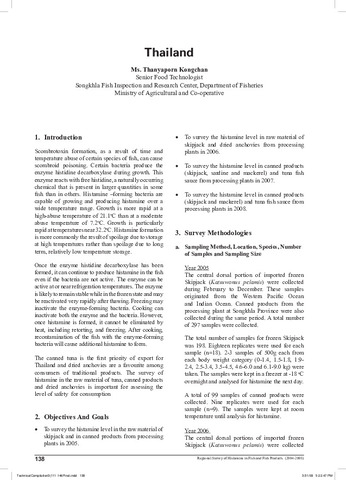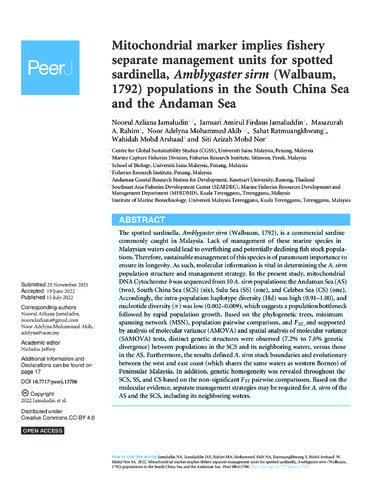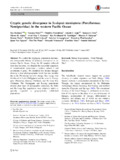Phylogeography of the Japanese scad, Decapterus maruadsi (Teleostei; Carangidae) across the Central Indo-West Pacific: Evidence of strong regional structure and cryptic diversity
Share
| dc.contributor.author | Jamaludin, Noorul-Azliana | |
| dc.contributor.author | Mohd-Arshaad, Wahidah | |
| dc.contributor.author | Mohd Akib, Noor Adelyna | |
| dc.contributor.author | Zainal Abidin, Danial-Hariz | |
| dc.contributor.author | Nghia, Nguyen Viet | |
| dc.contributor.author | Nor, Siti-Azizah Mohd | |
| dc.date.accessioned | 2023-03-20T07:23:52Z | |
| dc.date.available | 2023-03-20T07:23:52Z | |
| dc.date.issued | 2020 | |
| dc.identifier.citation | Jamaludin, N.-A., Mohd-Arshaad, W., Mohd Akib, N. A., Zainal Abidin, D.-H., Nghia, N. V., & Nor, S.-A. M. (2020). Phylogeography of the Japanese scad, Decapterus maruadsi (Teleostei; Carangidae) across the Central Indo-West Pacific: Evidence of strong regional structure and cryptic diversity. Mitochondrial DNA Part A, 31(7), 298–310. https://doi.org/10.1080/24701394.2020.1799996 | en |
| dc.identifier.issn | 2470-1394 | |
| dc.identifier.uri | http://hdl.handle.net/20.500.12561/1927 | |
| dc.description.abstract | The Japanese scad Decapterus maruadsi (Carangidae) is an economically important marine species in Asia but its exploitation shows signs of overfishing. To document its stock structure, a population genetic and phylogeographic study of several populations of this species from the central part of the Indo-West Pacific region was conducted using the mitochondrial cytochrome b gene. Genetic homogeneity within the Sundaland region’s population, including Rosario (the Philippines) and Ranong (Andaman Sea) populations was revealed with low nucleotide diversity (π = 0.001–0.003) but high haplotype diversity (h = 0.503–0.822). In contrast, a clear genetic structure was observed between this group and the northern Vietnam populations as revealed by FST, AMOVA and SAMOVA, while the central Vietnam population of Khanh Hoa is an admixed group between the two differentiated regional populations. The neutrality and mismatch distribution analyses supported a demographic expansion of D. maruadsi in between last Pleistocene to early Holocene period which influenced present day distribution pattern. Contemporary factors such as oceanic currents and different life history traits are also believed to play significant roles in the observed population structure and biogeographical pattern. Based on these results, recommendations on how stocks of the Japanese scad should be managed are offered. | en |
| dc.description.sponsorship | All of the collected specimens were permitted by participating SEAFDEC Member Countries who involved in Project entitled “Information Collection for Sustainable Pelagic Fisheries in the South China Sea and Andaman Sea.” (Funded by Japanese Trust Fund II Program, Southeast Asia Fisheries Development Center (SEAFDEC) from 2010 to 2015). | en |
| dc.language.iso | en | en |
| dc.publisher | Taylor and Francis | en |
| dc.subject | Decapterus maruadsi | en |
| dc.subject | phylogenetic analysis | en |
| dc.subject | nucleotide sequence | en |
| dc.title | Phylogeography of the Japanese scad, Decapterus maruadsi (Teleostei; Carangidae) across the Central Indo-West Pacific: Evidence of strong regional structure and cryptic diversity | en |
| dc.type | Article | en |
| dc.citation.volume | 31 | en |
| dc.citation.issue | 7 | en |
| dc.citation.spage | 298 | en |
| dc.citation.epage | 310 | en |
| dc.citation.journalTitle | Mitochondrial DNA Part A | en |
| dc.subject.asfa | carangid fisheries | en |
| dc.subject.asfa | population genetics | en |
| dc.subject.asfa | fishery management | en |
| dc.subject.asfa | population structure | en |
| dc.subject.asfa | mitochondrial DNA | en |
| dc.identifier.essn | 2470-1408 | |
| dc.identifier.doi | 10.1080/24701394.2020.1799996 | |
| dc.subject.scientificName | Decapterus maruadsi | en |
| local.subject | Decapterus maruadsi | en |
| local.subject | Japanese scad | en |
| local.subject | mitochondrial DNA cytochrome b | en |
| local.subject | population genetic | en |
| local.subject | phylogeographic study | en |
Files in this item
| Files | Size | Format | View |
|---|
This item appears in the following Collection(s)
-
MFRDMD Journal Articles [11]
These papers were contributed by MFRDMD staff to various national and international journals



